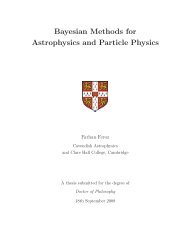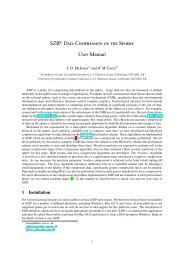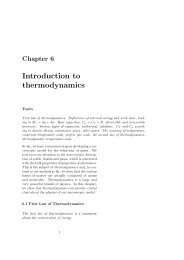Self study guide: Fortran 95 - University of Cambridge
Self study guide: Fortran 95 - University of Cambridge
Self study guide: Fortran 95 - University of Cambridge
Create successful ePaper yourself
Turn your PDF publications into a flip-book with our unique Google optimized e-Paper software.
First some things to note about the program:<br />
1. We can declare more than one variable <strong>of</strong> the same type at a time by<br />
separating the variable names with commas:<br />
real :: d, r, rres<br />
2. We can place more than one statement on a line if we separate them with a<br />
semicolon:<br />
d = 2.0 ; r = 3.0<br />
• Compile and run the program. Note the different output. The rule is that for<br />
integer division the result is truncated towards zero. Note that the same rules<br />
apply to expressions containing a constant. Hence:<br />
ires = 10.0 / 3 ! value <strong>of</strong> ires is 3<br />
rres = 10 / 3 ! value <strong>of</strong> rres is 3.0<br />
rres = 10.0 / 3.0 ! value <strong>of</strong> rres is 3.333333<br />
• Make sure you are happy with these rules; alter the program and try other types <strong>of</strong><br />
expression.<br />
Some expressions look a little odd at first. Consider the following expression:<br />
n = n + 1<br />
where n is an integer. The equivalent algebraic expression is meaningless, but in a<br />
program this is a perfectly sensible expression. We should interpret as:<br />
“Evaluate the right hand side <strong>of</strong> the expression and set the variable on the left hand<br />
side to the value evaluated for the right hand side”.<br />
The effect <strong>of</strong> the above expression is therefore to increment the value <strong>of</strong> n by 1. Note<br />
the role played by the ‘=’ sign here: it should be thought <strong>of</strong> not as an equality but<br />
instead as an “assignment”.<br />
The complex type represents complex numbers. You can do all the basic numerical<br />
expressions discussed above with complex numbers and mix complex and other<br />
data types in the same expression. The following program illustrates their use.<br />
• Enter the program, compile and run it. Make sure you understand the output.<br />
program complex1<br />
implicit none<br />
! Define variables and constants<br />
complex, parameter :: i = (0, 1) ! sqrt(-1)<br />
complex :: x, y<br />
x = (1, 1); y = (1, -1)<br />
write(*,*) i * x * y<br />
end program complex1<br />
9






